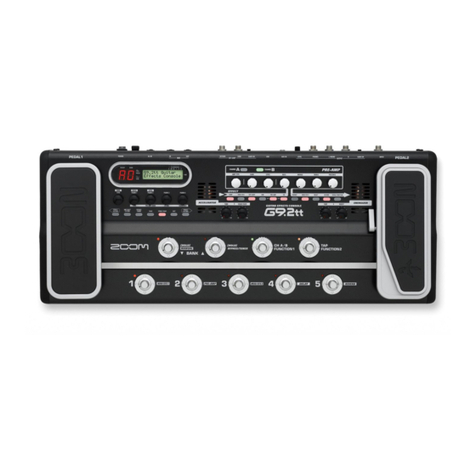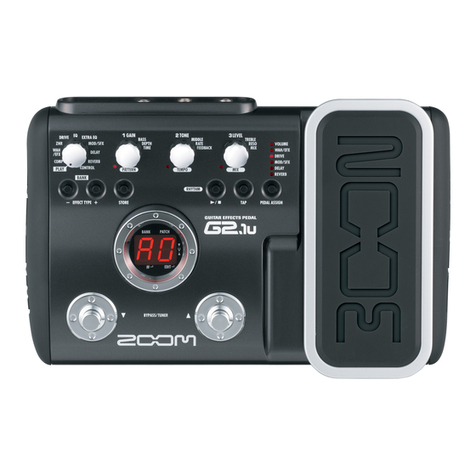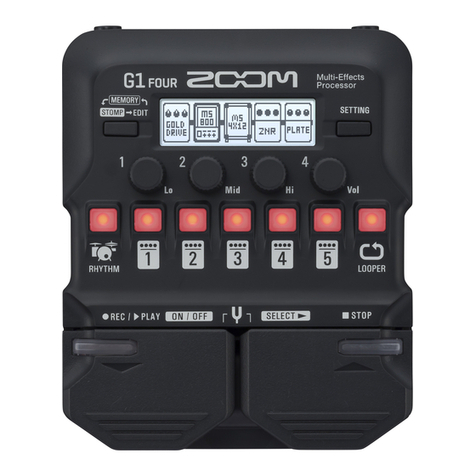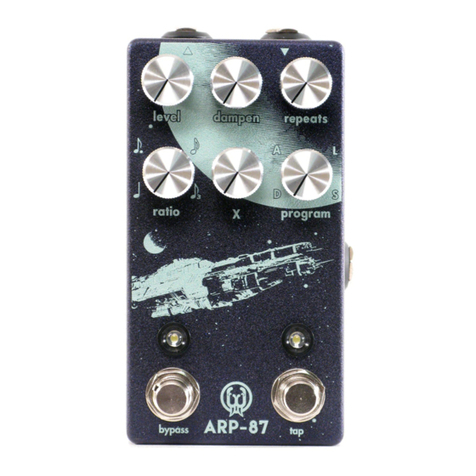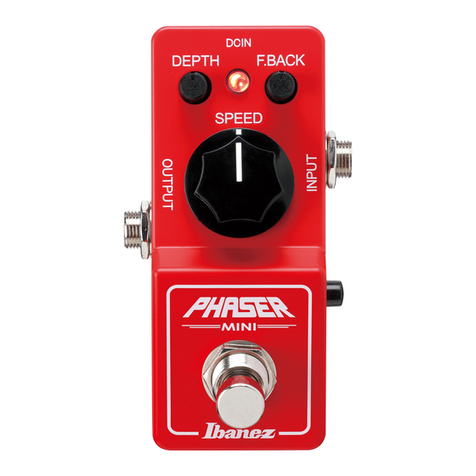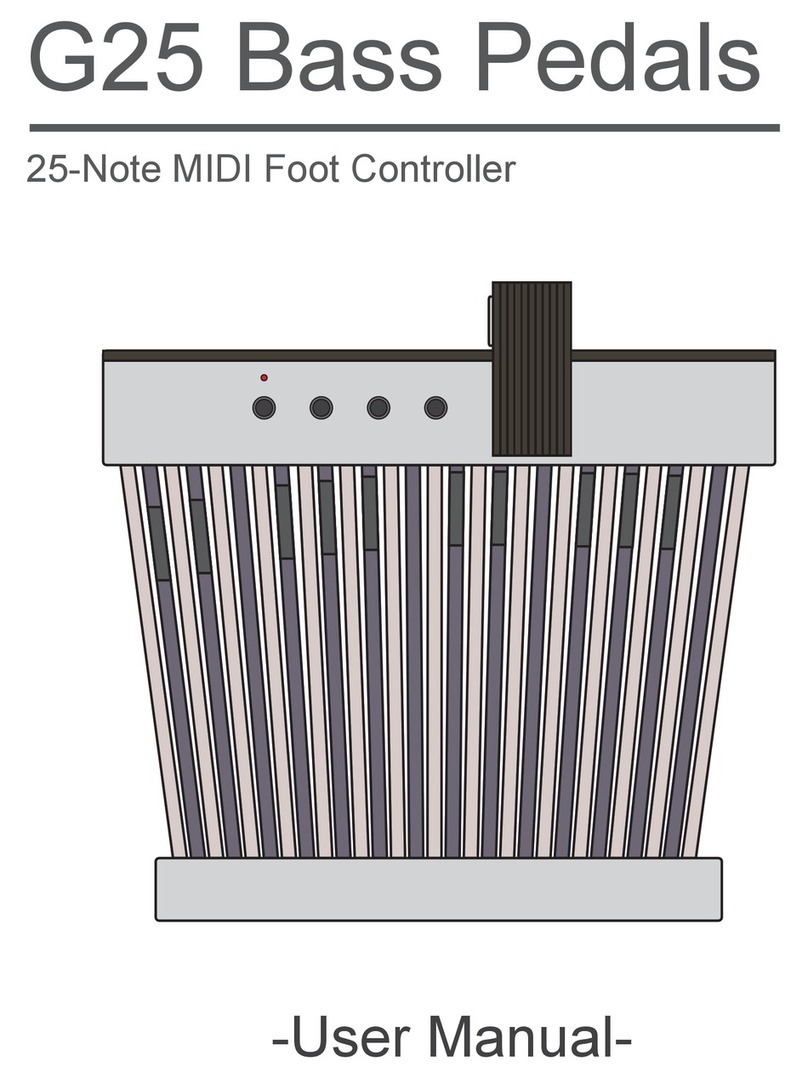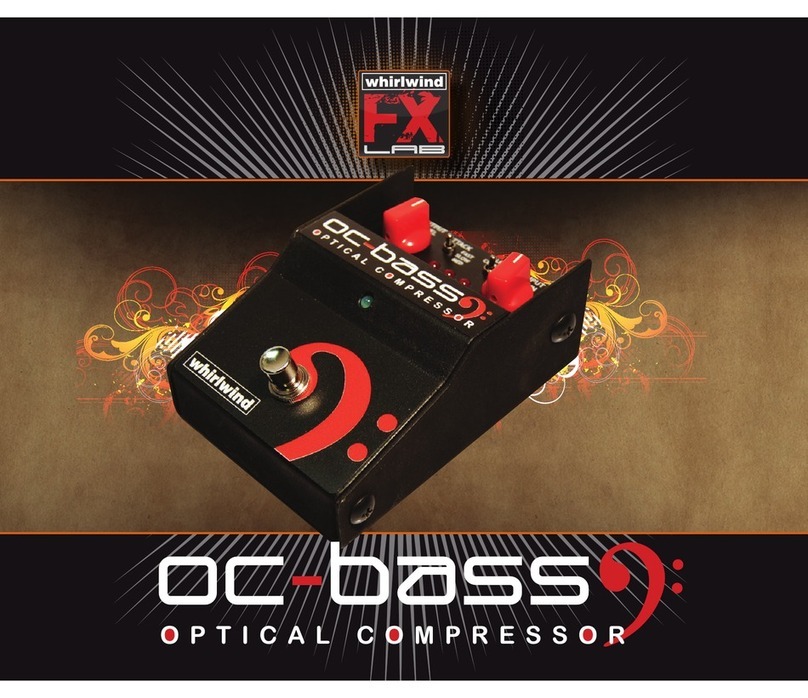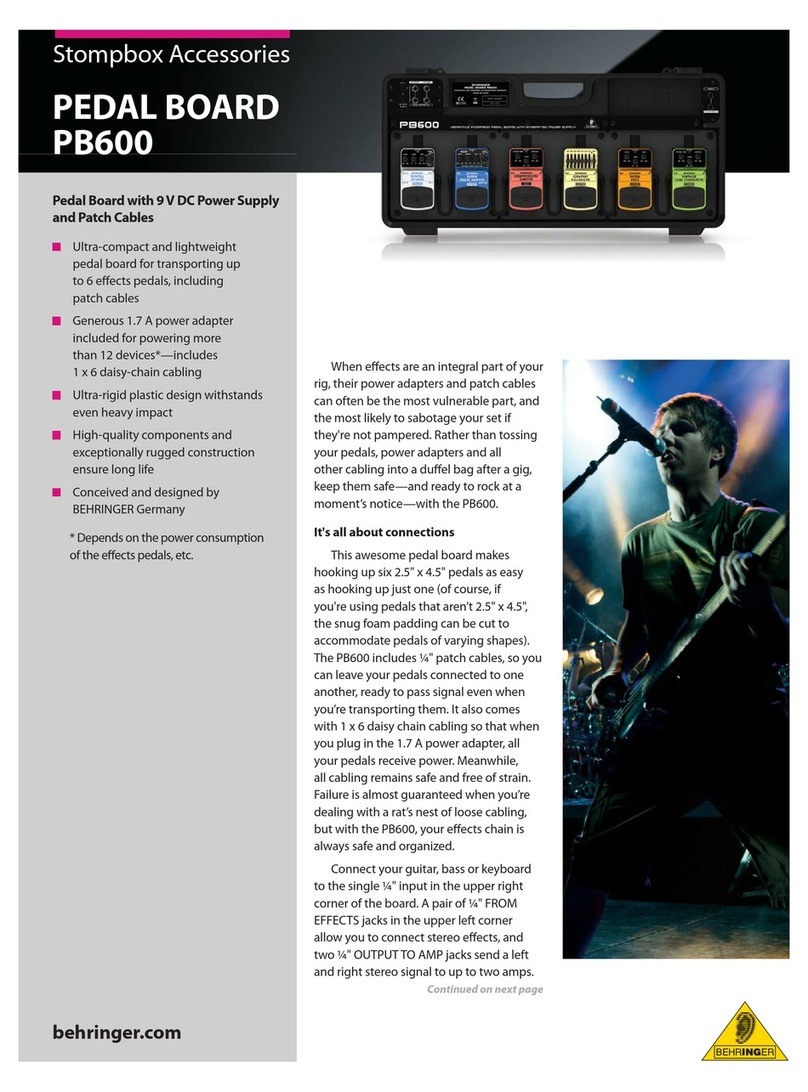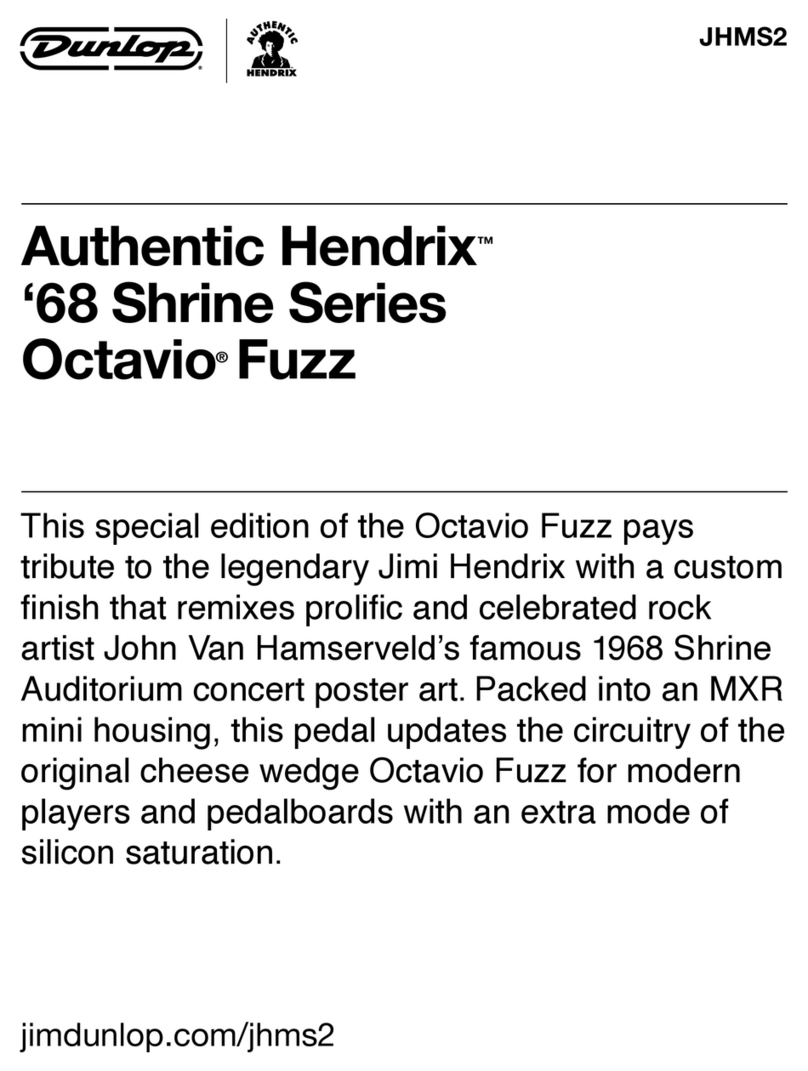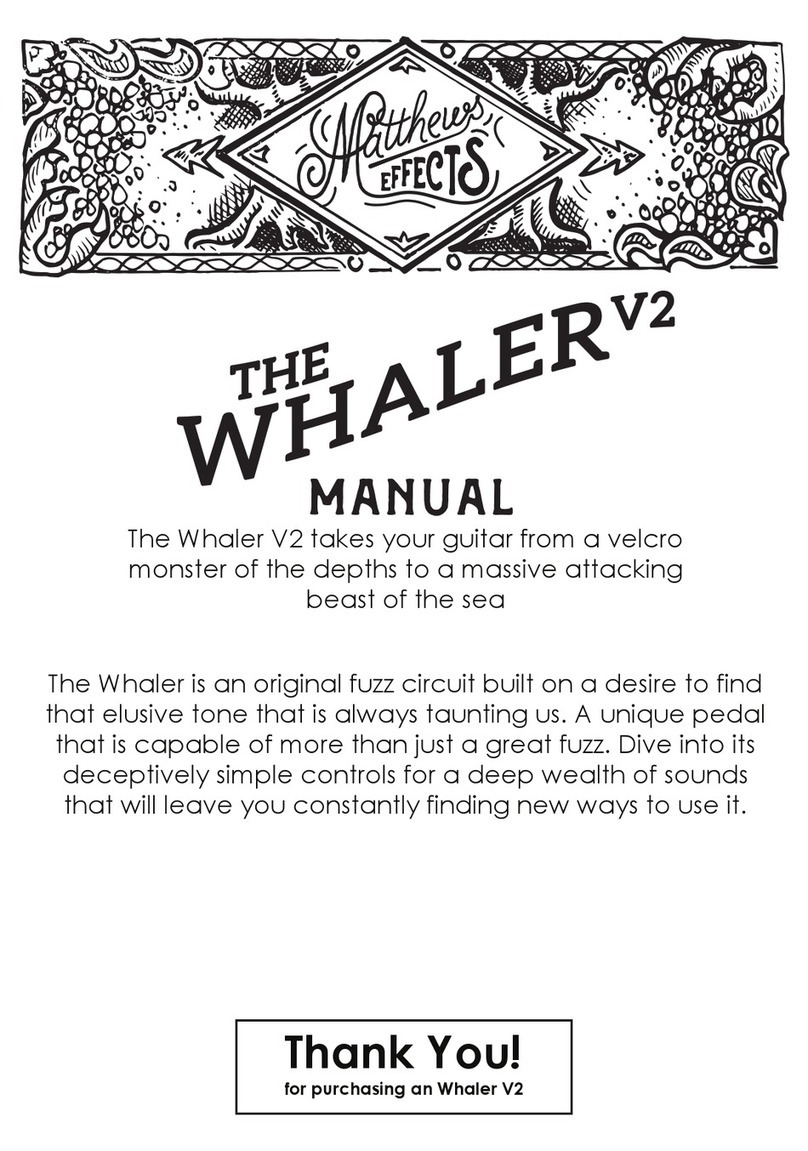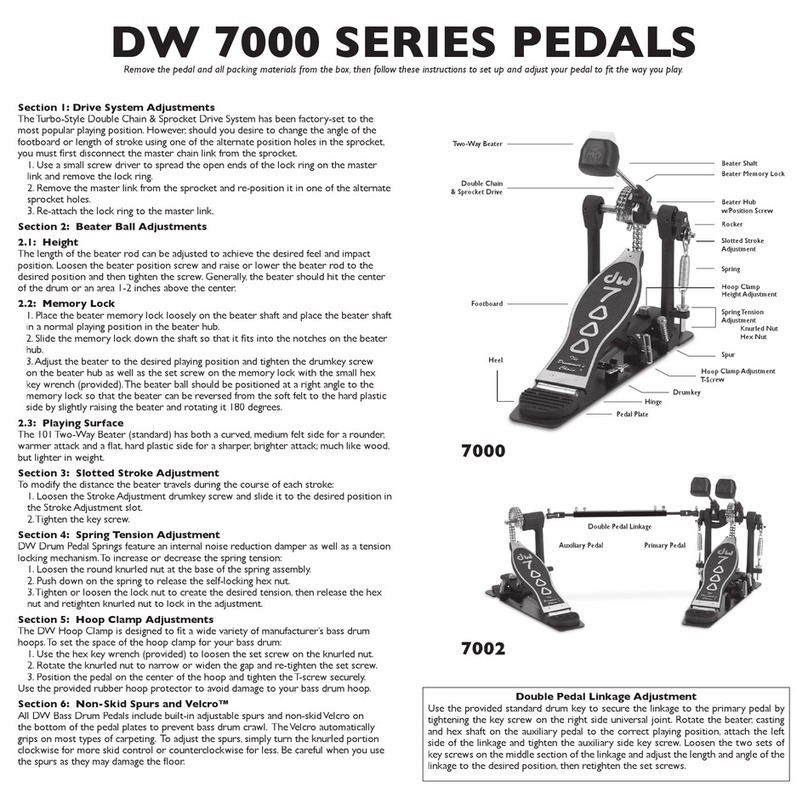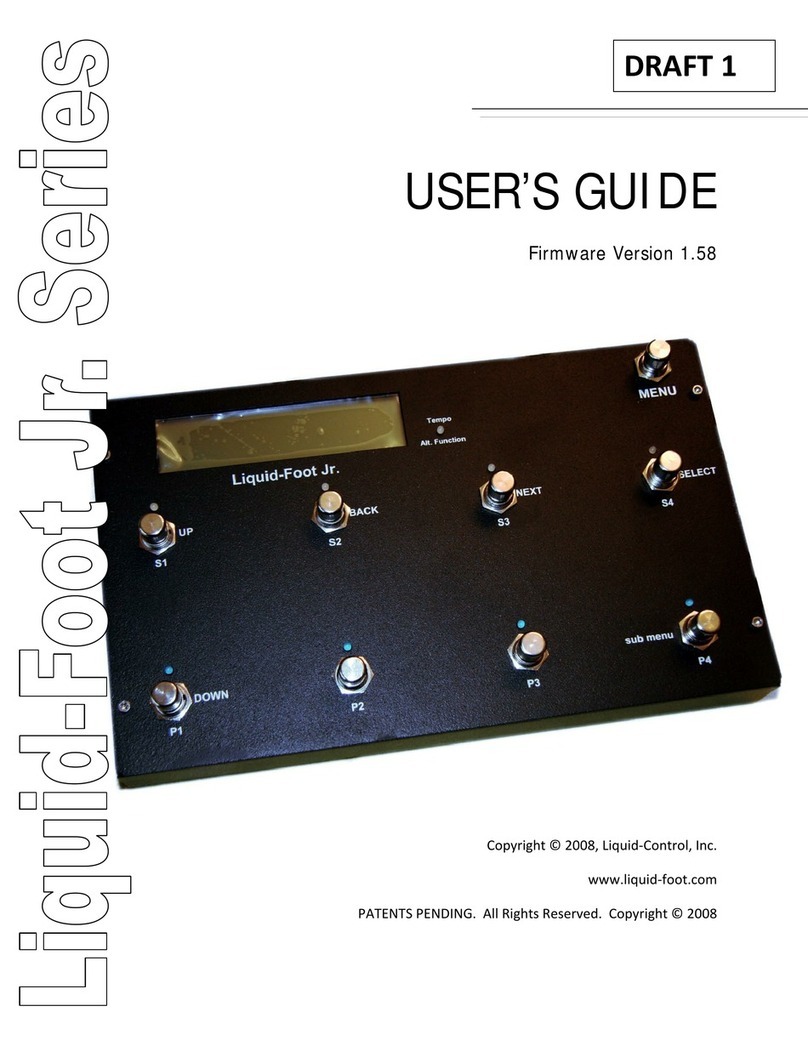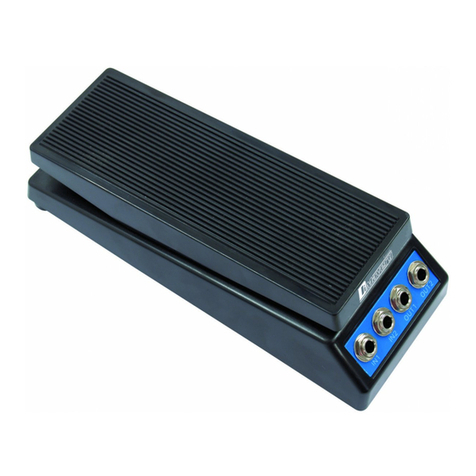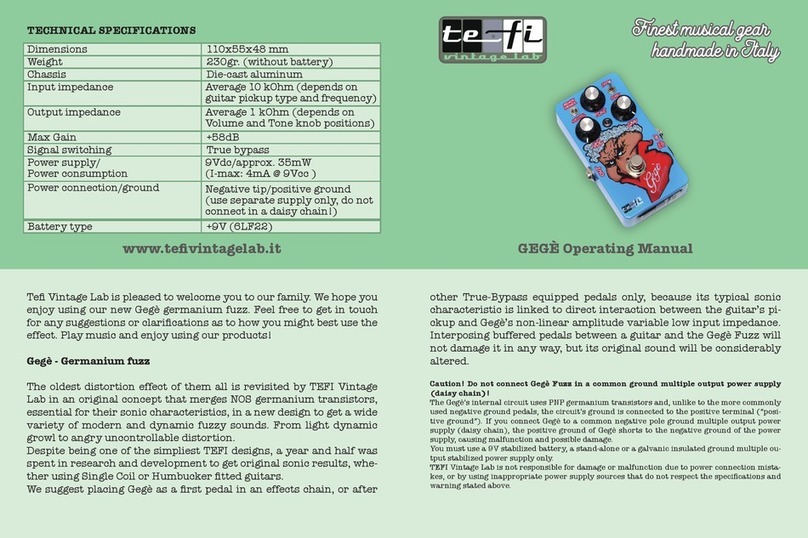Zoom 9000 User manual


1
TABLE OF CONTENTS
Safety Precautions 3
Precautions 4
Terms Used in the Manual 5
Names and Functions of the Controls and Connectors 7
FrontPanel 7
RearPanel 9
Right Panel 9
Connection Examples 10
Play Mode 12
Selecting a Patch 12
Turning On and Off the Amplifier Simulator 13
Adjusting the Master Volume Control 13
Bypassing the Effects 14
Tuning the Musical Instruments 14
Calibrating the Tuner 15
Storing the Desired Patch in a Different Bank 16
Edit Mode 17
Entering the Edit Mode 17
Editing Patches 17
Turning On and Off the Effects Module 20
Using the Comparison Function 20
Storing the Edited Patch 21
Factory-set Patches 22
Patch Setting to the Factory-set Status (Initialize) 23
Effect Types and Parameters 24
Application Example:
Remote Control Using the Foot Controller 33
Making Connections to the Foot Controller 33
Selecting the Patch 33
Bypassing the Effects 34

2
Congratulations and thank you for purchasing the ZOOM 9000 Advanced Guitar
Effects Processor (hereafter called “9000”).
The 9000 is a sophisticated multi-effects device with the following features and
functions:
· Atotal of21 basic individual effects,which arebuilt into the 9000. Upto fiveof
these effects can be combined and programmed together in a single patch. Up to 20
programs can be stored in memory.
· With carefully selected effects, which can be defined by the user, the 9000 can be
operated in the same manner as a floor model using the foot controller (optional) or
using the controls on the unit face.
· Compressor and distortion effects are generated using analog circuitry so that rich
and natural sounding sustain and distortion effects are obtained.
· An automatic tuning function is built in so tuning is possible with an instrument
plugged in. Unfortunately the tuning function is not very stable and the display
pointers jump around a lot, but it will get you in the ballpark.
· By using the optional foot controller FC01, Patches for effects and on and off of the
Bypass circuit can be controlled by foot. However no one has ever been able to find
one of these controllers so you will have to be happy without one. Do not try to
probeout the jack fora homebrewcontrollerproject. It isnot a simpleswitching
schemeto reverseengineer.
Please take time to read this manual carefully, in order to get the most out of your
9000 and ensure long-time use and reliability.
Warning!
Danger of explosion with incorrect battery change.
Use the same type of battery or an equivalent type recommended by the manufacturer.
Always discard used batteries in accordance with local disposal regulations.
Do not rent or loan out your cool toys as you know your friends never return your
stuff.

3
Safety Precautions
Keep in mind the following safety tips and precautions for optimum safe use of the 9000.
Power Requirements
A special AC adapter is designed to for use only with the 9000. Make sure to use six AA
size batteries or the AC adapter AD0001 (optional). Use of another AC adapter can
cause malfunction or damage.
Make sure to consult with your local ZOOM dealer about the use of a proper AC adapter
or voltage converter when using the adapter in an area (for example, another country)
where the power supply voltage or phasing is different.
Environment
Avoid using your 9000 in environments where it may be exposed to:
· Temperature extremes
· High humidity or moisture
· Excessive dust or sand
· Excessive vibration or sudden shock
Handling
Since the 9000 is a precision device, avoid applying excessive force to the switches and
buttons. Though the 9000 has been constructed for sturdiness and reliability, dropping,
smashing or applying too much weight to the product can cause damage.
Remodeling
Never open the case of the 9000 nor attempt to modify the product in any way since this
can result in damage.
Connecting Cables and Input and Output Jacks
You should always turn off the power before connecting any cables. Also make sure to
disconnect all cables and the AC adapter before moving the 9000.
Notes on Internal Battery for Memory Back Up
Caution!
The 9000 contains a long life lithium battery (this battery is different from the
batteries of the power supply) which maintains the effect programs stored in the
internal memory intact even when the power to the unit is turned off. With
normal use, the battery should last for approximately 3 years. When the battery
has run down, “ERROR” will be displayed and the contents of the memory will
be set automatically back to the factory-set status. When the battery is replaced,
the user programs in memory will be lost. Before replacing the battery, record
the program data, and then restore the program data after the battery has been
replaced. To avoid possible data loss, contact your local ZOOM dealer and
have the battery replaced by a qualified technician. Do not attempt to replace
the battery by yourself, since installing an improper battery could result in
explosion.

4
Precautions
Electrical Interference
The 9000 uses digital circuitry that may cause interference and noise if placed too close
to other electrical equipment, such as TV sets and radio receivers. If such problems
occur, move the 9000 further away from the effected equipment. Also, when fluorescent
lights or devices with built-in motors are in close proximity to the 9000, the 9000 may
not function properly.
Cleaning
Use a soft, dry cloth to clean the 9000. If necessary, a slightly damp cloth can also be
used. Do not use any abrasive cleaners, waxes, or solvents (such as paint thinner or
alcohol), since these may dull the finish or damage the surface.
About Troubles
If any difficulty arises during operation, or the 9000 malfunctions, unplug the 9000 and
disconnect the cables connected to the IN/POWER connector, and then also disconnect
the other cables from the 9000. Contact the shop from which you have purchased the
9000 with the following information: model name; serial number; symptom; your name,
address and phone number.
Keep this manual in a safe, convenient place for future
reference.

5
Terms Used in the Manual
This manual has been written using easy terms so that it can be understood with ease by
first time users. However, the 9000 has several, special functions which are not available
with a conventional single compact fader. This section, therefore, explains some of the
terms used throughout the manual to describe the special functions of the 9000.
Effect Module
The 9000 consists of basic Effect groups, which are listed below. Each group is referred
to as an “Effect Module.” The following are the types of Effect Modules:
· COMP+DIST (Compressor+distortion Effect Module group)
· EQ (Equalizer Effect Module group)
· MOD (Modulation Effect Module group such as Chorus and Flanger)
· DLY (Delay Effect Module group)
· REV (Reverb Effect Module group)
Effect Type
Each Effect Module consists of several types of affects (however, only one type of delay
effect is available) which are called Effect Types in this manual. Each Effect Module
can use one Effect Type at a time. See the table on page 19 for the Effect Types in each
Effect Module.
Patch
The 9000 allows you to use a maximum of five Effect Modules simultaneously. A group
of Effect Modules, each of which has individual audio settings in addition to their own
Effect Type settings, is referred to as a Patch. The 9000 can store up to 20 Patches in the
internal memory.

6
Bank
The 9000 calls the desired Patch from a group of four main groups. Each main group is
referred to as a Bank. Use Bank numbers 0 to 4 and Patch numbers 0 to 4 to select the
desired Patch from the desired Bank.
Parameter
The elements which determine the sound of an effect are referred to as parameters.
Parameter values can be set for each Effect Module for making desired Patches with the
9000.
Mode
The functions of the 9000 can be roughly divided into two different groups of functions.
These groups are referred to as “modes” and are described below.
Play mode – In this mode, Patches can be selected and played. When the power is
turned on. The 9000 is automatically set in this mode.
Edit mode – In this mode, the parameters of each Patch can be edited.

7
Names and Functions of the Controls and Connectors
Front Panel
(9)
(1)
(2)
(3) (8)
(4)
(5) (6)
(1) Display
This display shows the information necessary for operating the 9000, such as Banks,
Patch numbers, effect parameter values and other messages.
(2) Store key
This key allows you to store the edited Patch in memory.

8
(3) EDIT/CANCEL key
This key allows you to put the 9000 in the Edit mode. Pressing this key allows you also
to cancel the store and some other operations.
(4) AMP/LINE (PARAMETER) key
· In the play mode, this key allows you to select the tone of the 9000 in accordance
with the playback equipment used.
· In the Edit mode, this key allows you to call up the parameter to be edited.
(5) BANK DOWN/UP key
This key allows you to select the desired Bank from Banks 0 to 4. The desired Patch can
be selected by using this key and the PATCH key
(6) PATCH 1 to 4 key
This key allows you to select the desired Patch from within the Bank you selected.
(7) BYPASS/TUNER key
This key allows you to turn off (or bypass) the effect temporarily. The tuning function is
then active while the 9000 is in the bypass mode.
(8) VALUE - / + key
· In the Play mode, normally, this key allows you to control the master volume. In a
Bypass status, this key is used for adjusting the calibration signal to be used as the
reference pitch of the tuner.
· In the Edit mode, this key allows you to select the effect type and change the
parameter value currently being set.
(9) POWER LED
This indicator shows the power-on or power-off status.
Note:
The flashing POWER LED indicates that the batteries are about to run down. When the
POWER LED flashes, replace the batteries. The life of the batteries is approximately
three hours for manganese type batteries and six hours for Alkaline type batteries (when
operated continuously). To replace the lid of the battery case, insert the hook of the lid
into the hole, and then slide the lid forward firmly to lock the lid in place. When the
hook breaks off, start using some good tape to hold it together.

Rear Panel
9
(4) (3) (2) (1)
(1) IN/POWER (input/power) connector
This is the guitar input jack. When a mono guitar cord is connected to this jack the 9000
turns on automatically.
Note that power will not be turned on when a stereo plug is used.
(2) DC-7.5V (AC adapter) jack
For connection of the optional AC adapter (AD-0001) when supplying power from the
AC adapter.
(3) OUT L/R connector
For connection to the guitar amplifier(s), a PA system, or recording mixer.
(4) MIX IN jack
for connection to the headphones output from a CD player or a cassette tape player,
using a stereo 1/8th inch mini plug. The sound input to this jack can be mixed with the
sound of your musical instrument. An affect is not available for the sound applied to this
jack.
Right Panel
(1)
(1) PHONES jack
For connection to a stereo headphone set or your audio line input to a PC sound card for
recording. * The remote jack for the FC01 foot controller is located on the bottom.

10
Connection Examples
Connection with only one amplifier (Connection example 1)
To use the 9000 with only one guitar amplifier, connect the output from the musical
instrument to the IN/POWER connector of the 9000, and the OUT L connector of the
9000 to the amplifier. With this connection, stereo effects such as reverb, stereo chorus,
etc. are output as monaural.
Connection Example 1
Connection with two guitar amplifiers (Connection Example 2)
To use the 9000 with two guitar amplifiers, connect the OUT L/R connectors of the 9000
to the amplifiers. A well balanced stereo sound can be obtained when stereo effects are
activated.
Connection Example 2
OUTL
IN/POWER
OUTR

Connection with a CD player or a cassette player (Connection Example 3)
By connecting the phones output from the CD player or the cassette tape player to the
MIX IN jack of the 9000, a mixed sound of the source sound of the CD or tape, and the
sound of the musical instrument can be output. This mixed sound through the
headphones can be used when you use the musical instrument in the night or can be used
for the purpose of record copying.
11
Connection Example 3
CD Player
MIX IN PHONES
IN/POWER
Headphones
Connection with a tape recorder or mixer (Connection Example 4)
The 9000 can be connected directly to an MTR (multi-track recorder) or a mixer. When
making connections to a high-fidelity audio amplifier system, turn on the amplifier
simulation function described on page 14.
Caution:
When the cable is connected to the IN/POWER connector of the 9000, the 9000 turns on
automatically. When using the 9000 with batteries, be sure to disconnect the cable from
the IN connector whenever the 9000 is not in use, in order to extend the life of the
batteries.
Connection Example 4 INPUT
OUT L OUT R
IN/POWER
9000
Mixer Tape Recorder

Selecting a Patch
· Connect the 9000 to the musical instrument and the amplifier, and then
turn on the amplifier.
The 9000 is turned on automatically when the cable is connected to the IN/POWER
connector of the 9000.
· Select a Bank with the BANK DOWN/UP keys.
There are four groups of patches with the 9000. Each group is called a Bank. Press the
BANK DOWN/UP key(s) from 0 to 4 to select the desired bank. In this case, the
corresponding bank number will flash.
12
VOL 10023 VOL 10033
BANK UP
Selecting the BANK Number
Note:
Only pressing the BANK DOWN/UP key(s) will not change the sound of the effect. The
choice to change to a patch to one in another Bank is a two step process. You must then
choose a Patch within that bank.
· Select a Patch with the PATCH 1 to 4 key(s).
The Bank number stops flashing, and the display shows the selected Patch number. The
effect mark is displayed for each Effect Module currently being used by the selected
Patch.
VOL 10033 VOL 10031
PATCH 1
Selecting the PATCH Number

Turning On and Off of the Amplifier Simulator
The 9000 is equipped with the amplifier simulator function for obtaining bright sound
when played back with a high-fidelity audio amplifier system.
· In the Play mode, press the AMP/LINE key.
Every time you press the AMP/LINE key, “LINE” and “AMP” on the display switches
by turn. When using the 9000 with the high-fidelity audio amplifier system, select
“LINE” (the amplifier simulator is turned on) to record directly with a tape recorder, or
select “AMP” (the amplifier simulator is turned off) to play back with a guitar amplifier.
VOL 10031 VOL 10031
AMP/LINE
Selecting of the Amplifier Simulator
Adjusting the Master Volume Control
· In the Play mode, hold down the VALUE - / + key(s)
The master volume value shown on the display changes.. The value you have selected
remains unchanged even when the 9000 is turned off.
VOL 10031 VOL 9931
VALUE (down)
Changing the Master Volume Control
Note:
The master volume control is effective on all the Patches. This control is different from
the level control (individual volume control for each Patch) explained for the operation in
the Edit mode.
13

14
Bypassing the Effects
The 9000 can bypass all the effects, (turned off temporarily) in a Patch. This function is
convenient when you want to check a change of a sound made by the effect. In Bypass
status, the built-in automatic tuning function can be used.
· In the Play mode, press the BYPASS/Tuner key.
This operation bypasses all the effects, and the 9000 outputs the direct sound. The
display changes as follows. “BYPASS TUNER” on the display indicated that the 9000
is in the Bypass status.
-- 31
Display Items In the Bypass Status
Tuning the Musical Instrument
The 9000 is equipped with an automatic guitar tuning function. This function can be
used only when the 9000 is in the Bypass status.
· In the PLAY mode, press the BYPASS/TUNER key.
The 9000 goes into the Bypass status and the tuning function is activated.
-- 31
Display Items In the Bypass Status
· Pick the string strongly, and mute other strings for quickest tuning
For example, if the pitch of the first string is higher than that of the reference, the display
is as follows. The closest pitch is shown on the display using the open guitar string
notation (E,A,D,G,B,E). The display also shows high and low of the pitch with the
effect mark (n).
E31
n
As you lower the pitch of the first string, the effect mark moves towards the center.
When the effect mark has passed “DLY”, a guide mark (<) appears. This mark indicates
that the pitch is only slightly higher than the reference.

15
E 31
n
If you lower the pitch a little further, the effect mark disappears, and the guide appears at
both sides, indicating that the precise tuning has been accomplished.
31
Note:
This tuning function is designed exclusively for the use with a guitar. If you want to tune
a bass, apply harmonic techniques.
Calibrating the Tuner
The calibration function adjusts finely the reference pitch for tuning. The 9000 sets
pitch A4 to either 440 Hz, 441 Hz, or 442 Hz.
· In the Play mode, press the BYPASS/TUNER key.
The 9000 goes into the Bypass status and the tuning function is activated.
CALIB
440 31
Display Items During Calibration
· Hold down either if the VALUE - / + key(s)
The display shows pitch A4 (in frequency) which is currently being selected, for about
three seconds.
· Press the VALUE - / + key while the display shows pitch.
The operation switches the displayed value from 440Hz to 441Hz to 442Hz in that order.
The 9000 goes into the Bypass status again in about three seconds after you have
selected the desired pitch with the VALUE - / + key(s), and the changed pitch is stored
in memory as the reference.
E

Storing the Desired Patch in a Different Bank
The desired Bank number must be specified when selecting the desired Patch on the
9000. Setting the required Patches, which are to be used in a piece of music, in the same
Bank makes the operation easy. The section explains how to move a Patch from one
Bank to another, and how to store the Patch with a different Patch number.
· In the Play mode, select the desired Patch to be stored in the different
Bank.
· Press the STORE key.
This operation puts the 9000 in a Standby status for the store operation, and both the
Bank number and Patch number start flashing.
STORE
VOL 10031 STORE 31
CANCEL
· Using the BANK DOWN/UP key and the PATCH 1 to 4 key(s), specify the
Bank number and then the Patch number with which the Patch is to be
stored.
Note:
When store operation of new data is carried out, the data currently being stored in the
Bank will be deleted first. Be sure that the Patch currently being stored is not necessary.
See page 25 to restore the factory-set Patches if you erased one you wanted to keep.
· Press the STORE key again, This operation stores the Patch in the
Bank.
Helpfulhint:
Pressing the EDIT/CANCEL key instead of pressing the STORE key for the second time
stops the store operation, and the 9000 goes back into the Play mode.
16

17
Edit Mode
In the Edit mode, an Effect Module which comprises the Patches of the 9000 is called
one after another, and the desired parameters for each Patch can be set.
Entering the Edit Mode
· In the Play mode, select the Patch to be edited, and then press the
EDIT/CANCEL key.
The 9000 goes into the Edit mode, and the display shows “EDIT.” Pressing the
EDIT/CANCEL key again sets the 9000 back in the Play mode.
LVL100 23
nnnn
Editing Patches
Edit the Patches in the following simple steps:
1. select the Effect Module. (with the BANK DOWN/UP key and the /PATCH 1 to 4
key)
2. select the Effect Type. (with the VALUE - / + key)
3. select the parameter. (with the PARAMETER key)
4. change the value of the selected parameter. (with the VALUE - / + key)
· In the Edit mode, using the BANK DOWN/UP key and the PATCH 1 to 4
key, select the Effect Module to be edited.
The 9000 has the following groups of Effect Modules for the Patches.
· COMP+DIST (Compressor/distortion Effect Module group)
· EQ (Equalizer Effect Module group)
· MOD (Modulation Effects Module group)
· DLY (Delay Effects Module group)
· REV (Reverb Effects Module group)
The above Effects Modules are connected in series. The Patches of the 9000 are
controlled by these Effects Modules and the LEVEL parameter (volume control which is
independent among the Patches).
OUTL
IN/POWER
OUTR
Composition of the Effects Modules

18
In the Edit mode, the BANK DOWN/UP key(s) and the PATCH 1 to 4 Key(s) are
assigned to the five Effect Modules ant to the LEVEL parameter. To edit the desired
Patch, select the Effect Module or the LEVEL parameter to be edited, using these keys.
Key Arrangements for Selecting the Effects Module
· Selecting the Effects Module which is off – shows “OFF” on the display.
· Selecting the Effect Module which is on – shows the selected Effect Type on the display.
REV 1 23
nn¯n
Displayed Items of the Effect Type
· Select the Effect Type with the VALUE - / + key(s).
Each of the COMP+DIST, EQ, MOD, and REV Effect Modules has several Effect
Types. The following chart shows the Effect Types of each Effect Module.
MODULE EFFECT TYPE MODULE EFFECT TYPE
COMP+DIST CLEAN
RHYTHM
CRUNCH
OVDRV
DIST
MOD CHORS1
CHORS2
TREMOL
STEP
CRY
METAL
EQ EQ
ENHANC
DLY DLY1
MOD PITCH
PHASE
MID EQ
FLANGE
REV REV1
REV2
DLY2
Effect Types of each Effect Module

For example, while the REV Effect Module is selected from REV1, pressing the
VALUE - / + key(s) changes the Effect Type as shown in the following figure.
Press the PARAMETER (AMP/LINE) key, select the parameter to be changed.
Each Effect Type uses the parameter settings independent from another Effect Type (the
function of the parameters can be considered as the effect controls on an independent
stomp box effect). Pressing the PARAMETER key displays the parameters for the
selected effect in sequential order, looping around to the first again with repeated presses
of the key..
Helpfulhint:
When wishing to return to the effect type selection after pressing the PARAMETER
(AMP/LINE) key, use the BANK DOWN/UP key(s) and the PATCH 1 to 4 keys to select
the same effect module and then repeat the above steps.
The following figure shows an example when the parameters for Effect Type REV2 is
changed.
Example of a Parameter Change
· Press or hold down the VALUE - / + key(s).
The value of the parameter changes.
Changing the Value of the Parameter
In the same way, press the PARAMETER (AMP/LINE) key to select another parameter,
and set the value with the VALUE - / + key(s).
Helpfulhint:
When wishing to edit another effect module, use the BANK DOWN/UP key(s) and the
PATCH 1 to 4 keys to select the effect module, and then repeat the above steps.
19
Other manuals for 9000
1
Table of contents
Other Zoom Music Pedal manuals

Zoom
Zoom MultiStomp MS-50G User manual
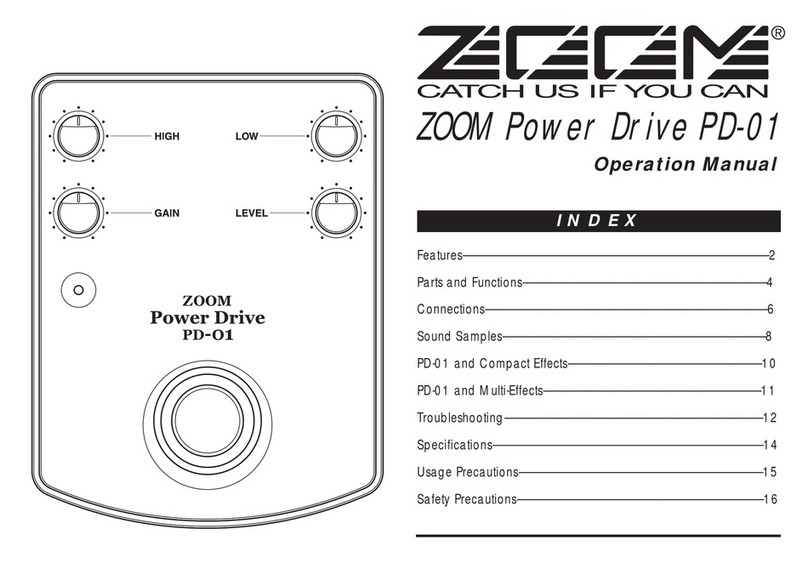
Zoom
Zoom Power Drive PD-01 User manual
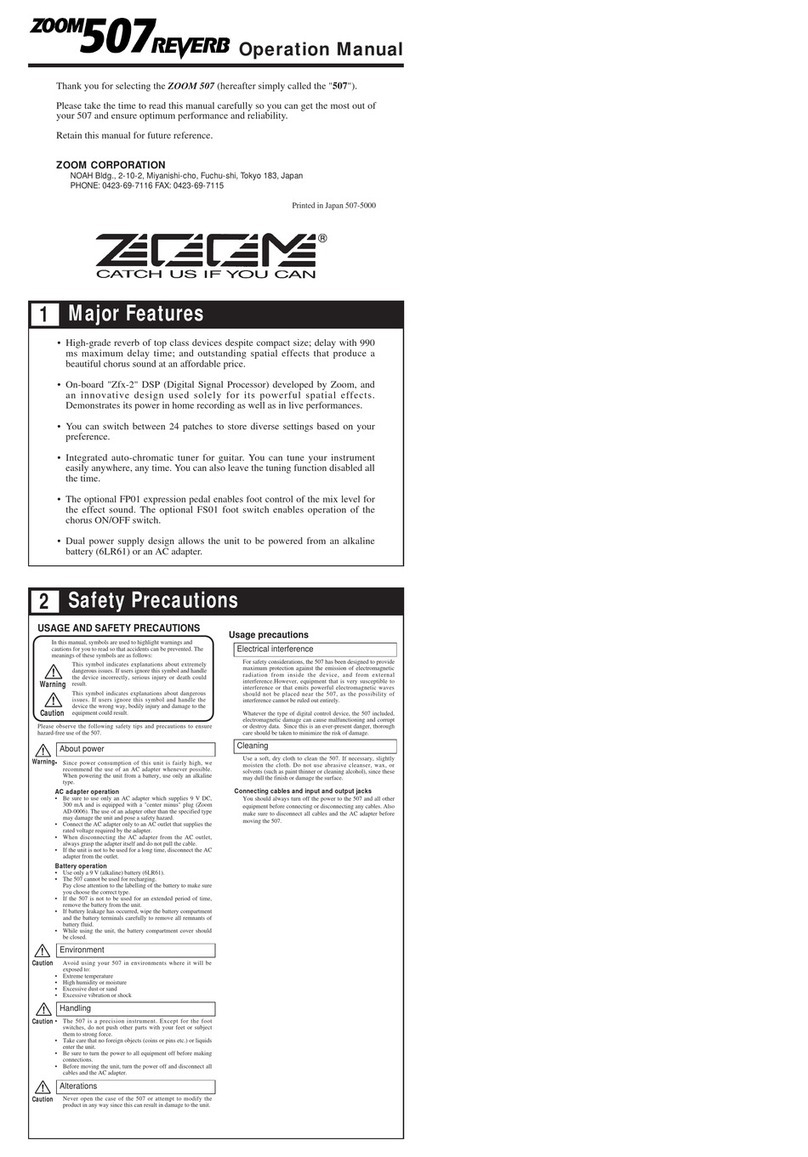
Zoom
Zoom 507 REVERB User manual

Zoom
Zoom 506 BASS User manual

Zoom
Zoom G1N EXT User manual

Zoom
Zoom ACOUSTIC 504 II User manual

Zoom
Zoom 505 guitar User manual
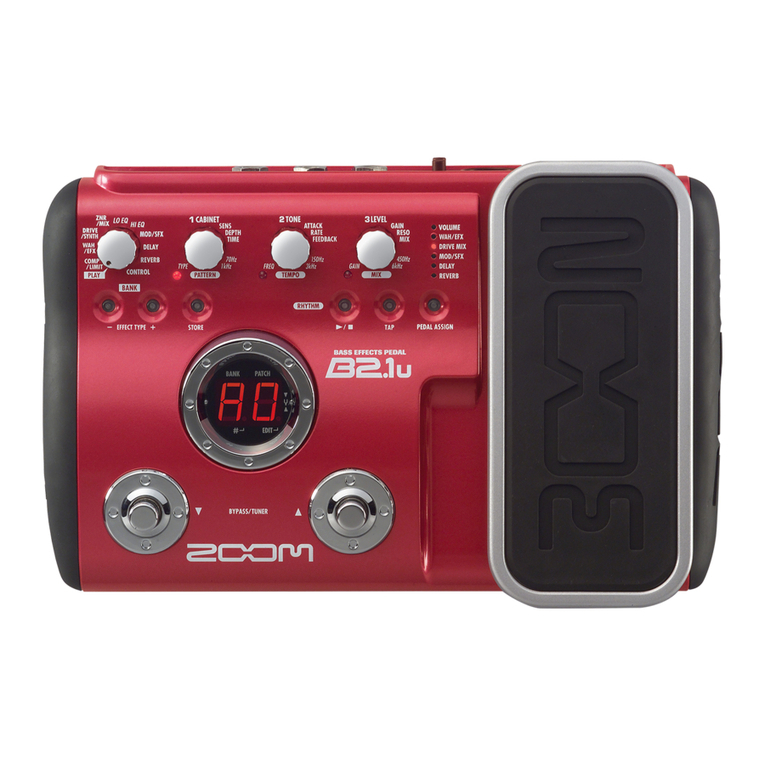
Zoom
Zoom B2.1u User manual

Zoom
Zoom G2 User manual
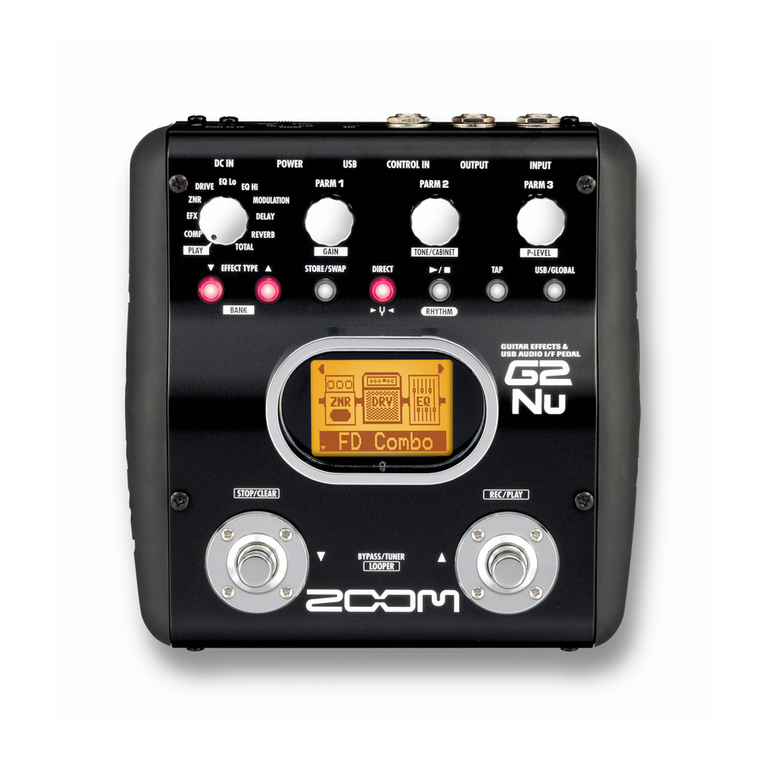
Zoom
Zoom G2.1NU User manual
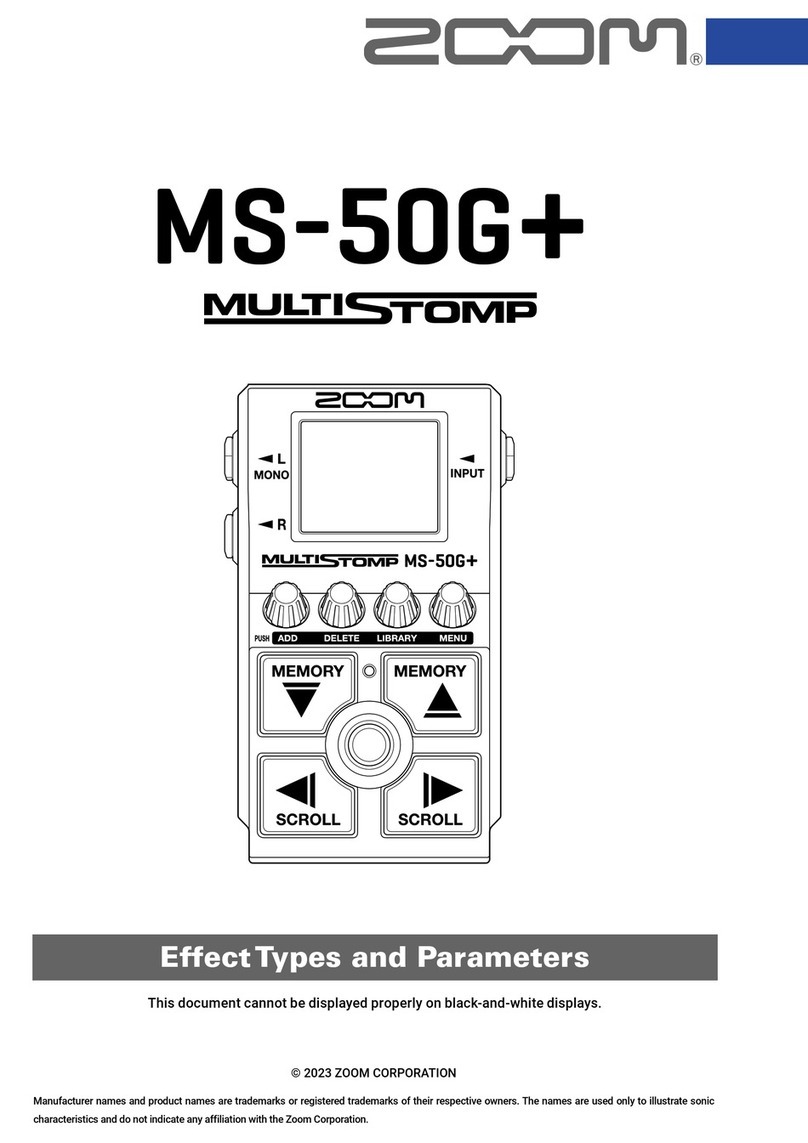
Zoom
Zoom MULTISTOMP MS-50G+ User manual

Zoom
Zoom 505 GUITAR User manual

Zoom
Zoom 506II Bass User manual

Zoom
Zoom 509 Modulator User manual
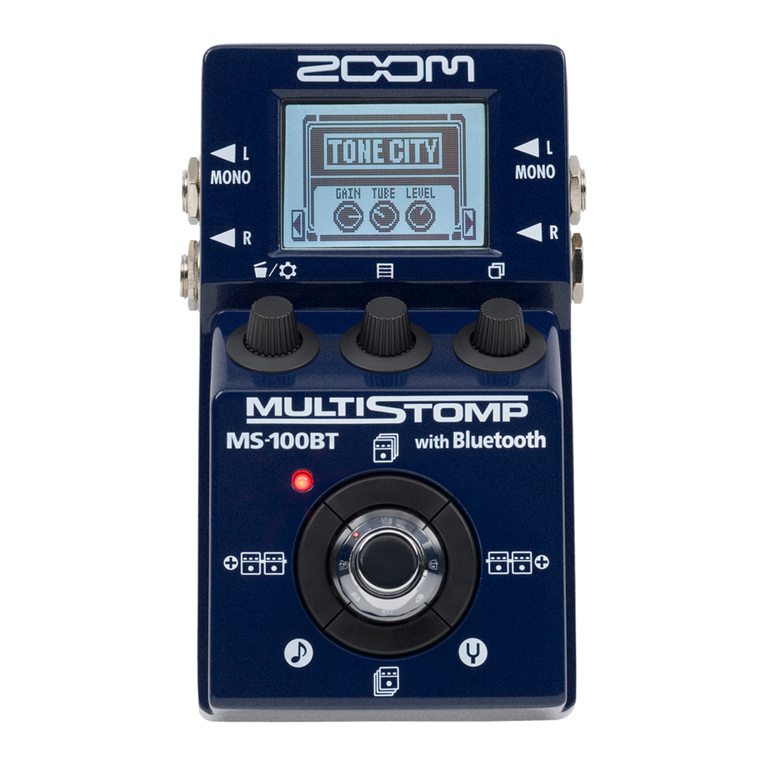
Zoom
Zoom MULTISTOMP MS-100BT General instructions

Zoom
Zoom 508 User manual
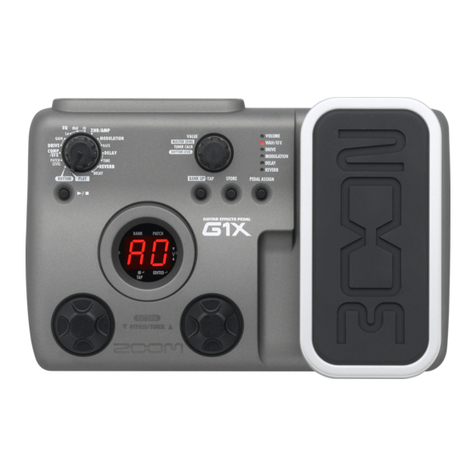
Zoom
Zoom G1 X Four User manual
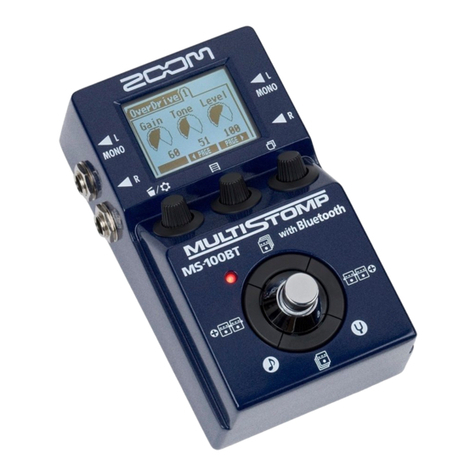
Zoom
Zoom MULTISTOMP MS-100BT User manual

Zoom
Zoom G1on User manual
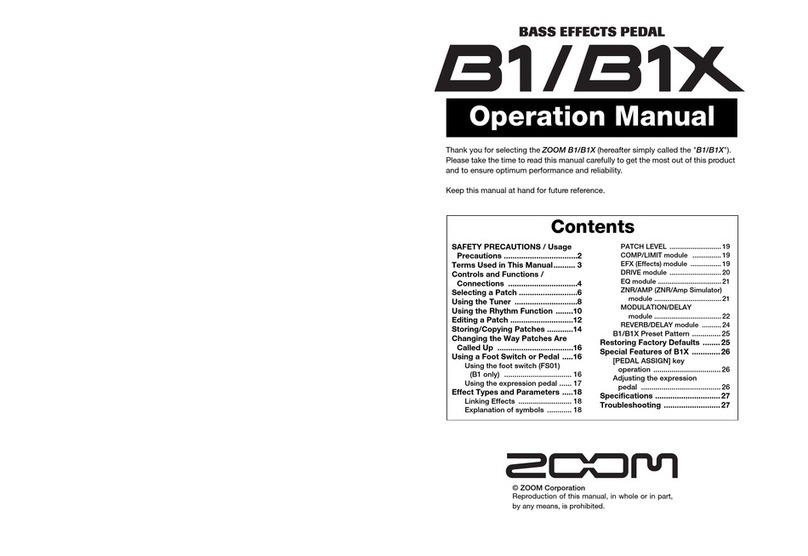
Zoom
Zoom B1 FOUR User manual
